| TKh49 (Ferrum 47) | |||||||||||||||||||||||||||||||||||||||||||||
|---|---|---|---|---|---|---|---|---|---|---|---|---|---|---|---|---|---|---|---|---|---|---|---|---|---|---|---|---|---|---|---|---|---|---|---|---|---|---|---|---|---|---|---|---|---|
 TKh49-1 in Chabówka | |||||||||||||||||||||||||||||||||||||||||||||
| |||||||||||||||||||||||||||||||||||||||||||||
| |||||||||||||||||||||||||||||||||||||||||||||
| |||||||||||||||||||||||||||||||||||||||||||||
| |||||||||||||||||||||||||||||||||||||||||||||
| Pokropiński 2007, p. 256 | |||||||||||||||||||||||||||||||||||||||||||||
The Fablok T3A also known as TKh49 or Ferrum 47 / 724 is a class of Polish steam industrial tank locomotive. It was built by Fablok in 1948-1961 years.
| TKh49 (Ferrum 47) | |||||||||||||||||||||||||||||||||||||||||||||
|---|---|---|---|---|---|---|---|---|---|---|---|---|---|---|---|---|---|---|---|---|---|---|---|---|---|---|---|---|---|---|---|---|---|---|---|---|---|---|---|---|---|---|---|---|---|
 TKh49-1 in Chabówka | |||||||||||||||||||||||||||||||||||||||||||||
| |||||||||||||||||||||||||||||||||||||||||||||
| |||||||||||||||||||||||||||||||||||||||||||||
| |||||||||||||||||||||||||||||||||||||||||||||
| |||||||||||||||||||||||||||||||||||||||||||||
| Pokropiński 2007, p. 256 | |||||||||||||||||||||||||||||||||||||||||||||
The Fablok T3A also known as TKh49 or Ferrum 47 / 724 is a class of Polish steam industrial tank locomotive. It was built by Fablok in 1948-1961 years.
The locomotive is based on a draft from the years 1927-1929; seven locomotives of the factory designation T1A, basing upon Austrian license, were built by Fablok then. [1] Its development with a superheater was Fablok T2A (Ferrum 29 or Tkh29), of which eleven were built before World War II. [2] The name Ferrum came from Ferrum Ironworks, for which it was developed. [2] The technical documentation survived until after World War II and ten more T2A were manufactured. [2] Due to big need of industrial locomotives in looted post-war Poland, it was decided to develop it into a simplified class of locomotive, factory name T3A or Ferrum 47, from 1947 year. Among other it lacked a superheater. [3] At least 437 examples were made in the years 1948 - 1961, including 30 to China, 3 to Romania and 3 to Hungary. [3] Some factory records indicate 480 locomotives made, but details are not confirmed. [3] Later production locomotives, with more welding adopted, were referred to as Ferrum 724. [3] In China the locomotives were designated as XK 13 and several examples of the class were reported to be working in 1993, with at least three preserved thereafter. [4]
These locomotives worked exclusively in industry, like coalmines, ironworks, chemical works, and were usually designated with TKh prefix, meaning 0-6-0T freight locomotives in Polish State Railways designation system, merged with serial numbers. Only in 1996 one locomotive was acquired by the Polish State Railways (PKP) for its museum depot in Chabówka, and formally designated as PKP class TKh49, namely TKh49-1, thus being the newest PKP steam locomotive. [5]
The locomotive TKh49-1 is preserved at the Museum of Vehicles and Railway Technology in Chabówka, whilst thirteen more are in other museums or as monuments. [6] Several are in working condition. After industrial service, several locomotives have been exported to the United Kingdom for use on heritage railways as detailed below.
| Number | Name | Railway | Livery | Status | Notes |
|---|---|---|---|---|---|
| 2871 | "" | Churnet Valley Railway | Green | Awaiting Restoration | Owned by "TKh Support Group". Arrived April 2014 from the Spa Valley Railway, after purchase by Members of the CVR MPD. Funds being acquired for eventual restoration. |
| 2944 | Hotspur | Churnet Valley Railway | Green | Operational | Owned by "TKh Support Group". Entered service June 2014 after 12-month restoration by members of MPD following purchase by Members of the MPD. Already done ~1500 miles since restoration! |
| 3135 | Spartan | Swindon & Cricklade Railway | Red | Stored, Awaiting 10 year overhaul | Bought by the S&CR in December 2014 from the Spa Valley Railway. |
| 3138 | Hutnik | Appleby Frodingham Railway | Red | Awaiting Overhaul | Purchased by the AFRPS in 1993, and brought back to Scunthorpe shortly afterwards. It was used for over 17 years on passenger trains, but in 2009 was found to be in need of boiler repairs. |
| 4015 | Karel | Avon Valley Railway | PKP Green | Operational | Imported to UK and moved to the Avon Valley Railway. Withdrawn in 2013, and sent to the Flour Mill in the Forest of Dean for overhaul. Returned to traffic September 2016. |
| 5374 | Vanguard | Plym Valley Railway | Black | Under Restoration | Arrived in UK in 1992, and entered service on Northampton & Lamport Railway. Sold in November 2016 to a new owner. Boiler requires overhaul with the aim of being back in steam by 2017. |
| 5387 | General Maczek | Stoomcentrum_Maldegem (Belgium) | Brown | Under Restoration | Used in Poland until 1990 as a switch engine in a cement yard. In 1992 bought - with TkH 5387 - by the Northampton & Lamport Railway. Back in service condition in 2000. Sold after few years of touristic service to Stoomcentrum_Maldegem (2006). Loaned to CFV3V in 2020. |
| 115 | "" | Shougang steel work plant railway | Black | Stored | Sealed in Shijingshan Headquarters of Shougang in 2019 |
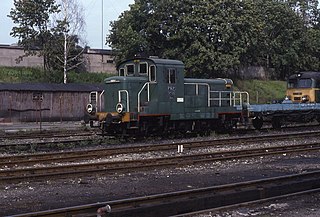
SM30 is a Polish series of diesel shunting locomotives used by PKP and industry, built by Fablok, Chrzanów. They were also used for a local traffic.

SM42 is the PKP class for a Polish shunter diesel locomotive for shunting and light freight traffic, built by Fablok in Chrzanów.
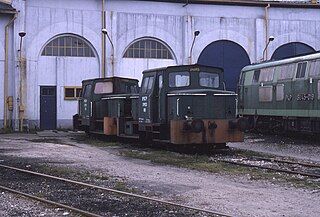
SM03 is the name of a Polish diesel locomotive class in the PKP railway operator designation. The letters SM describe a diesel shunting locomotive.

The SM04 is a low power, Polish built shunter, formerly operated by PKP and is an improved version of the SM03.

SP42 is the name for a Polish diesel locomotive used for passenger services.
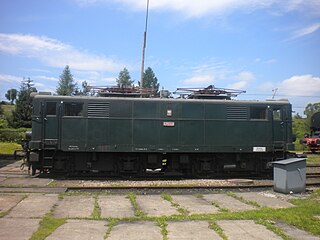
The PKP class EP03 is a type of electric locomotive used by Polish railway operator Polskie Koleje Państwowe (PKP).
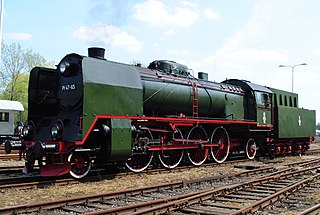
PKP Class Pt47 is a Polish steam locomotive. An improvement of the successful pre-war PKP class Pt31 class, the main difference is the addition of circular tubes in the fire chamber, thereby significantly increased boiler performance. This class also featured a superheater and many have mechanical stokers to feed coal into the firebox. 180 locomotives were built in total between 1948 and 1951. The designation stood for fast passenger (P) 2-8-2 (t) locomotive designed in 1947.
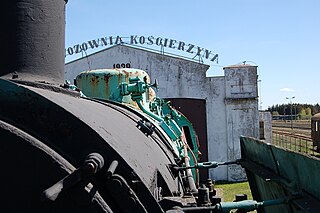
Railway Museum Kościerzyna is a Polish railway museum located in Kościerzyna, Pomeranian Voivodeship. The museum is located in place of a now defunct locomotive depot near Kościerzyna railway station.
The exhibit consists mostly of steam locomotives, but several diesel and electric locomotives, as well as electric multiple units and diesel multiple units are also available for visitors.
Besides rolling stock displayed in the open air, inside the shed visitors can also see several exhibitions of machines and devices connected with Polish railway history.
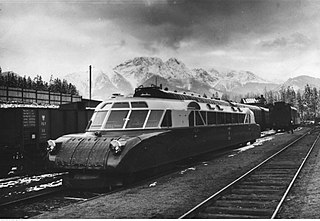
Luxtorpeda – a popular name of the famous Polish railcar from the 1930s.

Fablok is a Polish manufacturer of locomotives, based in Chrzanów. Until 1947 the official name was First Factory of Locomotives in Poland Ltd., Fablok being a widely used syllabic abbreviation of Fabryka Lokomotyw, among others as the company's telegraphic address. It is now named "BUMAR - FABLOK S.A. (corporation)". Fablok is located in the town of Chrzanów in Lesser Poland. As of 2009, Fablok no longer builds new locomotives.

PKP class Ol49 is a class of ordinary passenger (O) 2-6-2 (l) steam engine designed in 1949 and used in Poland by the Polskie Koleje Państwowe (PKP). A total of 116 were built between 1951 and 1954, 112 for the PKP and four for export to North Korea, by Fablok in Chrzanów.
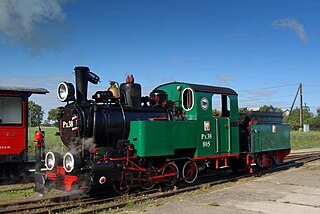
Px38-805, named Leon, is a preserved Polish 600 mm narrow gauge steam locomotive built by Fablok in Chrzanów, Poland. It was the only locomotive of PKP class Px38, and one of three built locomotives of Fablok W5A type.

The PKP class Lyd1 is a narrow gauge diesel locomotive class, covering two similar models built in Poland: WLs150 built by Fablok, and its development WLs180 (803D) manufactured by Zastal. It was used by Polish State Railways (PKP) on the narrow gauge railways in Poland, and on industrial railways.

Px27 is a class of Polish State Railways (PKP) 600 mm narrow-gauge steam locomotive built by Fablok in Chrzanów, Poland, in 1929. Only two locomotives of this class were made, and one, Px27-775, is currently preserved.
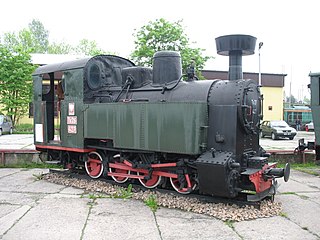
Tx26-427 is a preserved Polish 600 mm narrow gauge steam locomotive built by Fablok in Chrzanów, Poland. It was the only locomotive of Fablok W2A type, included into PKP class Tx26 along with W1A type.

The PKP class TKt48 was a class of freight tank (TK) 2-8-2 (t) steam locomotive of the Polish State Railways (PKP). Originally intended for use in suburban traffic, the locomotives were later mainly used for passenger and freight trains on the low mountain range in southern Poland. Six locomotives were sold to Albania.

PKP Class Pt31 is a Polish steam locomotive of Polskie Koleje Państwowe, designed for hauling heavy long-distance passenger trains, built in 1932-1940. The designation stood for fast passenger (P) 2-8-2 (t) steam locomotive designed in 1931.

PKP Class Pu29 is a Polish steam locomotive of Polskie Koleje Państwowe, designed for hauling heavy long-distance passenger trains, built in 1931. The designation stood for fast passenger (P) 4-8-2 (u) steam locomotive accepted in 1929.

PKP Class OKz32 is a Polish tank locomotive of Polskie Koleje Państwowe, designed for hauling passenger trains in mountain regions, built in 1934-1935. The designation stood for passenger (O) tank (K) 2-10-2 (z) steam locomotive accepted in 1932.

The WLs40 and WLs50 are narrow gauge diesel locomotives built in Poland, used mostly on industrial railways. A small number was used by Polish State Railways (PKP) as Ld1 class on narrow gauge railways in Poland.